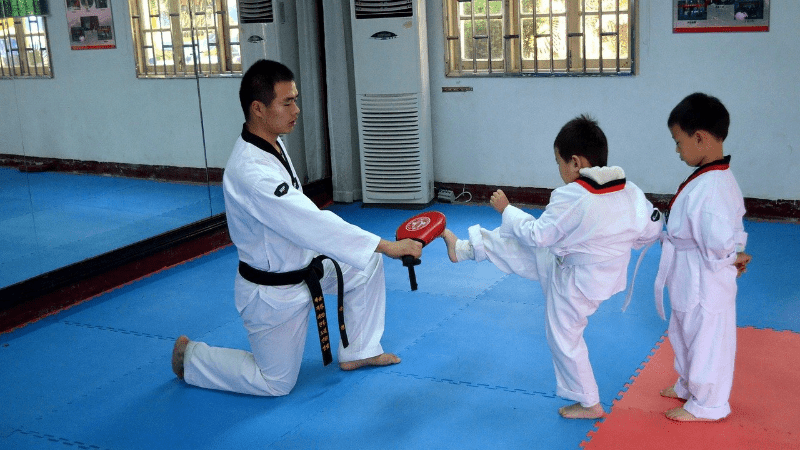One of the most common questions a parent asks centers around whether their child should learn martial arts and whether Taekwondo is safe for kids when compared with other sports. Having had this conversation with many, many parents I can address some of these concerns and highlight hidden benefits too.

Taekwondo is quite safe for children. In youth classes most injuries in Taekwondo are nothing more serious than a bruise or sprain. Given the popularity of Taekwondo among parents of young children, most child classes will focus on the non-contact training, such as technique drills, forms (scripted patterns of punches and kicks), and pad-work.
So that is the quick summary. Now if you’re interested in knowing why so many parents feel Taekwondo is safe for kids, keep reading.
Benefits
Before we get into the risks of Taekwondo training, it is important to note one of the main of the benefits your child will enjoy. Namely, martial arts practice is great exercise. In this age of tablets and phones, I’m sure you’d like to see your child spending less time in front of a screen. But, if you just toss him or her outside, who are they going to play with? All the other kids are indoors playing on their tablets!
Not so in Taekwondo schools. There, your son or daughter will be surrounded by children their own age (as most classes are separated by age groups) and will be fully engaged in fun and exciting exercise. Additionally, if your child is especially young (four or so) they’ll benefit from the motor skill, balance, and overall proprioception; something lacking in most public school education, in my opinion.
Other important benefits include:
- Socialization – surrounded by peers, your child will learn important social skills.
- Self confidence – whether it’s breaking a board or earning their first new belt, kids confidence grows exponentially from martial arts training.
- Dealing with stress – it’s as true for kids as it is for adults – exercise will help your child deal with stress in a healthy way.
- The basics of self defense – Taekwondo is not primarily focused on self defense, but one of the primary ways a child avoids being bullied is by projecting confidence.
- Respect and self discipline – Showing respect for their sabom (coach), and being able to control themselves, are some of the main byproducts of Taekwondo training.
Now, with all the benefits outlined, let’s talk about some of the risks.
Common Injuries
The majority of injuries that your child is likely to encounter are nothing serious. These will primarily be bruises and scrapes from partner drills, falling to the mat, and sparring. Slightly more serious in nature are joint sprains and strained muscles. A wrist or finger sprain may result from improper fist formation or poor wrist alignment when punching a bag, or during sparring.
In the majority of cases, these types of injuries are treated with nothing more complicated than soap, water, and a bandage, or bag of frozen peas and elevating the in injured limb to help reduce swelling. In a day or two your child will be fully healed.
Significantly less common are more serious injuries such as concussion or broken bones. In my youth I never witnessed either in a dojo, but that doesn’t mean it never happens. Concussions, while rare, can be caused during intense sparring sessions or tournament bouts, where full(er) contact is the norm, so you may choose to keep your child from tournament until they’re older.
In either case, the obvious thing to do, should your son or daughter suffer such an injury, is to bring them to a physician for examination and proper treatment.
Comparison to other Youth Sports
It is important to keep things in perspective when judging risk. After all, the leading cause of death in minors is auto accident, but virtually all parents still place their children in cars. So when judging whether Taekwondo is safe for kids, we need to compare it with similar, or alternative activities.
- Nearly 50% of head injuries suffered by those under 14 are the result of bicycling, skateboarding, or skating.
- Football produces more injuries than all youth sports, with a rate of 3.56 per 1000 athletic exposures.
- Girl’s soccer is second at a rate of 2.46 per 1000 exposures.
- Boys wrestling comes in at 2.02 per 1000 exposures.
- Next is girl’s basketball at 1.87.
- After that is boy’s basketball at 1.54.
So where is Taekwondo? Unfortunately the exact numbers are hard to uncover, but from the data available, we can determine that, on the whole, Taekwondo is safer for your child than some of the most popular youth sport activities.
Making Taekowndo Safe for Your Child
It goes without saying that your child’s safety is your number one priority. To that end, there are a number of things that you can do to help your child practice Taekwondo safely.
- Having your son or daughter wear the prescribed protective equipment such as hand and foot pads, chest protectors, helmets, and mouth guards.
- Teach your child to follow his sabom’s instructions at all times.
- Help your child practice his/her techniques at home; especially relating controlling the power of their punches and kicks.
- You should also speak to your child’s coach and inquire about how past student injuries have been handled and what measures are taken daily to prevent them.
- Inquire about the coach’s first aid training credentials.
- Look about the dojang (training hall). Is it clean? Are there safety pads present? Is the floor covered in foam matting? Ask yourself “Would I feel safe here?“.
- Observe regular training classes as well as belt promotions, as they can vary widely in intensity.

The Verdict
Like any sporting activity, Taekwondo training carries the risk of injury. And while the majority of injuries your child should expect are nothing serious, there is the chance of significant harm. Fortunately, we have also seen that Taekwondo has some of the lowest rates of injury of any popular sports that you might also be considering for your child.
The ultimate decision rests with you, the parent. However, if you’re asking for my opinion, I would suggest enrolling your son or daughter and seeing how the feel about it. If they’re like most active kids, they’ll fall in love with being allowed to punch and kick things as much as they like. And you’ll enjoy the benefits that come with having your child in an environment of structure and discipline.
Sources:
